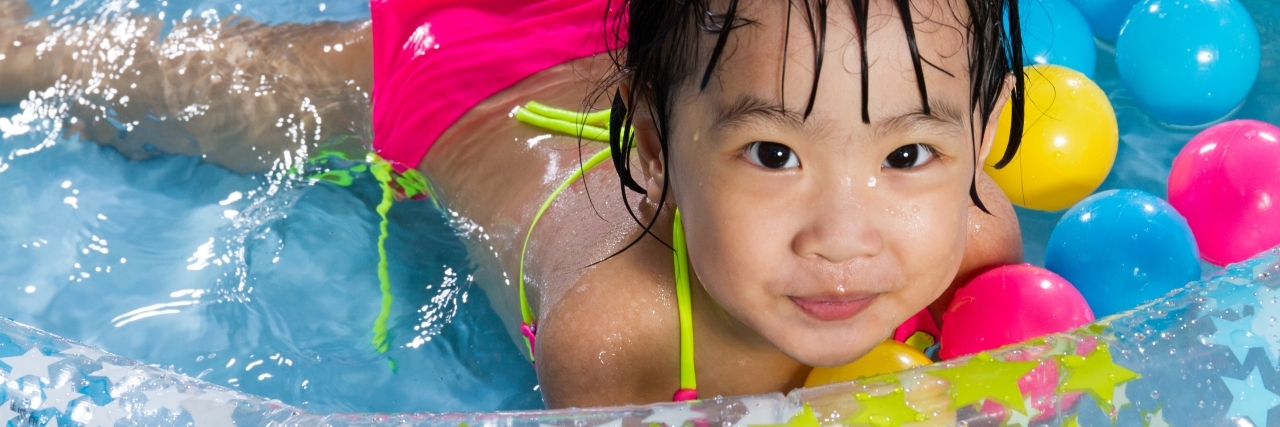If your child goes to public school, then you know what summer means. While the break is perfect for family fun, it can also mean that therapies received through the school are on hold until late August. For some kids, this can lead to regression.
Cerebral palsy is unique in that it is a non-progressive disorder. That means the abilities your child achieves are theirs to keep, though it may require therapy to keep them active. You don’t have to be a therapist or coach to keep your child active through the summer. Check out these five activities that can keep them moving.
1) Water play.
At home “aquatics therapy” is the best! Even children with severe cerebral palsy can benefit from getting in a pool. For smaller children, you may just supervise them playing in a kiddy pool. If they are moving and smiling, that’s great!
For older children, you can adapt floaties for the big kid pool. A possible adaptation is sewing a loop of fabric around a pool ring long enough that the ring comes to your child’s chest. For children with less trunk control, this is best. Kids with milder cases, affecting one side or their balance, may do well with simply a life vest in the water. In water, gravity is less strong, so they can move more freely. It also relaxes their muscles, which can be hypertensive with CP. Often, kids who utilize wheelchairs can walk while they are in the water. It’s great for their health, and it’s fun!
2) Painting.
The kiddy pool is also a great way to contain fun you wouldn’t normally allow in the house. Painting can benefit both gross and fine motor skills. Help your child change into some play clothes, then break out the washable paint! Finger paint is great for this activity. It washes off easily, but kids don’t have to focus on holding a brush to use it. They can use fingers, toes, fists, whatever they need to do to make a masterpiece! When they’re done, just take a hose to the pool, and your child if he or she enjoys it!
3) Riding bikes.
This one does require some extra equipment. There are bikes and trikes which are already adapted for children with CP, but they can be pricey. If your kid doesn’t already have an “army” bike or one with a high back seat, it’s time to get creative. Baby swings, the blue plastic kind with harnesses, and carseats can be repurposed as a bike seat. Even if your child doesn’t have pedaling down, it can be fun for them to hold the handlebars while you push! Look for pedals with straps, or add straps, to keep your little one’s feet from dragging.
Also, if your child has a gait trainer, turn them loose on the bike track. As long as the other kids are careful, your child may have fun keeping up with them on their own special “bike.”
4) Indoor “play” therapy.
Educational electronic toys can be beneficial. They don’t even have to be age-appropriate, just focus on abilities. Those letter pads can be effective for working on communication, spelling, and hand-eye coordination. Breaking out an iPad is exciting in the summer as well, but you may want to limit screen time. Colored ring stackers, blocks, wooden puzzles, and crayons are great for developing coordination.
5) Read!
Depending on the severity of your child’s CP, they may or may not be able to hold a book, focus their eyes on words, or read aloud. However, kids with limited physical abilities tend to be sponges. They soak in everything around them. Select age-appropriate books for your child that look interesting, or let your child pick a few. This is also a great way to teach your child about your local library. Read aloud to your child daily as part of your evening wind-down routine.
Kids whose parents read do better in school and at work later on. Even if your child is non-verbal, reading to them will expand their vocabulary (the words they recognize), relieve boredom, encourage imagination, and may even help them communicate with the world around them. There have been countless tales of non-verbal children learning to use assistive devices later in life. How do they start out of the blue knowing how to form sentences and use proper grammar? They absorbed it.
The activities you choose will depend on your child’s age, ability, and interests. These five are just a start. Try to pack as many fun, educational field trips as possible into three months. It’s great for everyone’s health and mental well-being to get out of the house and have some fun!
The Mighty is asking the following: Create a list-style story of your choice in regards to disability, disease or mental illness. Check out our Submit a Story page for more about our submission guidelines.

